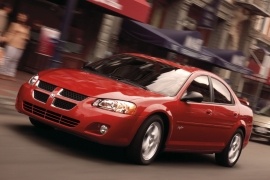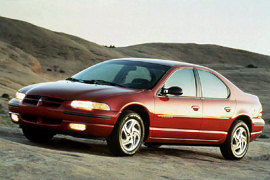DODGE Stratus Models/Series Timeline, Specifications & Photos
First production year: 1994
Engines: Gasoline
Part of the cloud-series vehicles, the Stratus shared its JR platform with the Chrysler Cirrus and the Plymouth Breeze, but it was the last survivor of this series of vehicles.
In 2001 it became obvious that the "cloud-car" concept was a failure, and the sales were slow. Yet, Chrysler decided to keep the Stratus and even refreshed its design. The car was quite reliable and pleased its customers, but the design trends were already different, and there were just two trim levels to choose from.
Chrysler penned the Stratus during the bio-design era, and that trend was already gone. Unfortunately, that means that the curved lines of the bodywork were no longer up to date. Moreover, introducing a new front fascia that featured Viper-inspired headlights and a new cross-hair grille was not enough to increase the car's sales.
Inside, the car received a few improvements in the safety sector. However, the optional ABS didn't look good for a vehicle produced in 2001. At the front, Dodge installed a pair of bucket seats covered in velour. At the same time, leather upholstery was offered as an option. In the back, the 60/40 split-folding bench could accommodate three passengers and provided access to the trunk. There was a wrap-around feeling for the driver created by the dashboard's look. The white dials with red needles looked sporty, albeit the four-door sedan was not exactly a sports car.
Under the hood, the base version named SE featured a 2.4-liter inline-four engine. At the same time, the top trim level, the ES, boasted a 2.7-liter V6 powerplant that provided 200 ponies.
While the Chrysler Cirrus got the better bits and pieces of the interior, the Dodge Stratus could have been bought for less money and still offer a sportier character.
Chrysler turned its attention toward meteorology when it named its siblings, and thus the car-people found out that the Cirrus are higher clouds than the stratus clouds, and so was with the cars. The Chrysler was more expensive and more luxurious, while the Dodge Stratus was more of a down-to-earth kind of vehicle.
Its aerodynamic profile, with a narrow front end and slim headlights, started the car's ascending lines, which ended with the trunk lid upper than the base of the windshield. But that didn't stop there. The curved body panels and the soft edges made the car looked like it was carved by air. Yet, it was just a regular four-door sedan designed for families.
Inside, the Stratus featured five seats with two bucket-seats at the front and a bench in the back. Its velour upholstery was nicely trimmed and fitted. The cabin was roomy for full-sized adults, even in the back. In the back, there was room for three if there was a shorter trip. For the dash panel, Dodge chose rounded shapes, following the bio-design trend. Its white dials from the instrument panel were very visible.
Unlike its more expensive brother, the Cirrus, the Stratus was offered with a choice of three engines ranged between 2.0-liter and 2.5-liter V-6. The latter was carried over from Mitsubishi. Apart from the 130 hp version, the others were available exclusively with a four-speed automatic transmission, which was offered as an option for the base model.

